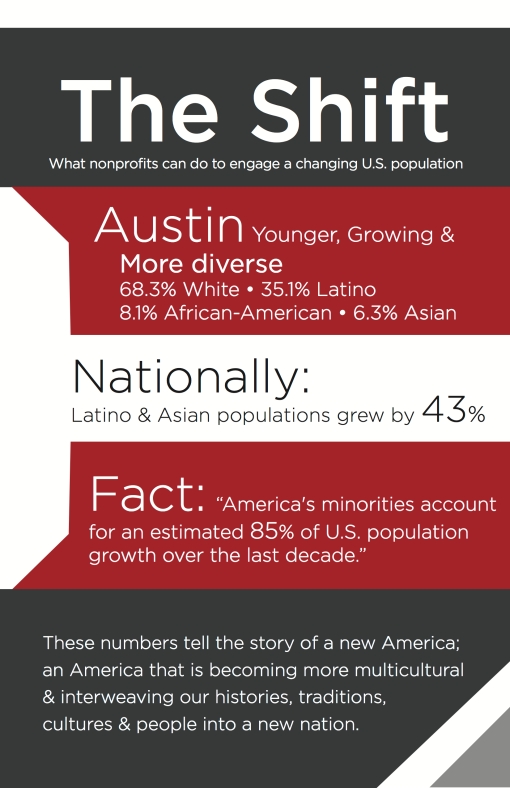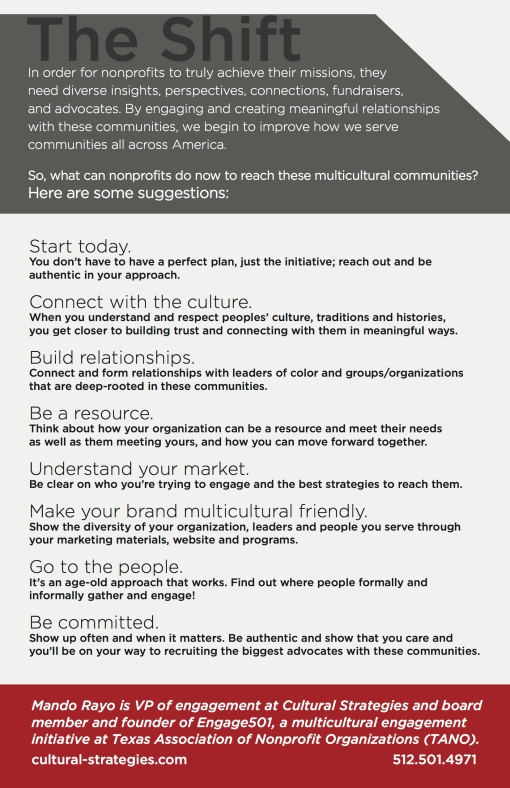2011 is the year of The Shift. We’re seeing a lot of changes happening in Austin, throughout Texas and America. Unless you’ve been hiding under a rock, you know the population trends are changing in every community across our nation and forming the New America. An America that is younger, growing and more diverse. This year, with the support of TANO, Austin Community Foundation, Sooch Foundation and others, I’ve had the opportunity to launch Engage501 and connect with many nonprofit leaders across Texas and equip them with strategies that will help them build relationships with Latino and Multicultural communities that will ultimately create fundraisers, board members, volunteers and advocates within these communities. It’s been a great experience connecting with nonprofits, learning about their successes and areas where they need help, and I look forward to continuing the conversation.
Want to get started? Read my article on The Shift.
The Shift: What nonprofits can do to engage a changing U.S. population
By Mando Rayo
In case you’ve been under a rock, you should know that right now we’re on the verge of a major population shift, and your organization may not be ready.
The shift is this: According to the most recent Census brief, “Overview of Race and Hispanic Origin 2010,” both the Hispanic and Asian populations grew by 43 percent. Consider the fact that “America’s minorities account for an estimated 85 percent of U.S. population growth over the last decade” and more than half of the increase is due to the Latino population, which is now at 50.5 Million. (*U.S. Census) These numbers tell the story of a new America; America that is becoming more multicultural and interweaving our histories, traditions, cultures and people into a new nation.
To say that nonprofits aren’t ready for this shift implies that nonprofits don’t already engage this population, at least not as donors, board members, volunteers and advocates. For many nonprofits, it’s hard to visualize more minorities on this side of the table. But at the same time, we must also questions whether we’re serving these populations as best we can. If we’re not connecting with those who can help us, why would we assume we’re reaching all of those who need us?
This is not an obstacle, it’s an enormous opportunity.
By engaging and building trust with Latinos, African-Americans, Asians and all diverse populations, nonprofits stand to benefit from authentic leadership on their board that goes beyond tokenism, fundraising opportunities that have gone untapped by mainstream organizations, increased awareness and engagement with services, programs and volunteer activities and relevance in a growing multicultural America.
In order for nonprofits to truly achieve their missions, they need diverse insights, perspectives, influence, connections, fundraisers, and advocates and by engaging and creating meaningful relationships with these communities, we begin to improve all communities across America.
As we know when we build trust with volunteers and donors, they are more likely to give even more of their time, talent and treasure. A few fundraising examples include $1 Million raised with low wage workers through United Way and local grocer-HEB, $125,000 raised through what might be the first Hispanic giving circle in the country, FuturoFund Austin and nationally, $4.7 Million raised with a Spanish radio telethon with Univision and St. Jude’s Hospital.
Now let’s get practical. What can nonprofits do now to engage with these multicultural communities? Here are some suggestions:
Start today. You don’t have to have a perfect plan, you just to do it; reach out and be authentic in your approach.
Connect with the culture. When you understand and honor peoples’ culture, traditions and histories, you get closer to building trust and connecting with them in meaningful ways. Take time to understand peoples’ backgrounds, experiences and motivations. Remember, multicultural groups are not monolithic.
Build relationships. If you’re looking for board members, build relationships with formal and informal leaders from these communities. Don’t just go with the usual suspects, reach out to new and upcoming leaders. Connect and collaborate with cultural groups and organizations that are deep-rooted in these communities.
Be a resource. Think about how your organization can be a resource to these communities. Take time to understand their needs, wants and aspirations. It’s about meeting their needs, your organizations’ needs and meeting in the middle or reaching the sweet spot. Once you hit the sweet spot, you can move forward together.
Understand your market. Be clear on whom you’re trying to engage and the best strategies to reach them. To reach young professionals, use leadership opportunities, social events and online networks; to reach families, be flexible and utilize family friendly activities and to reach new immigrants, utilize church networks and Spanish language media.
Make your organizational brand multicultural friendly. Show the diversity of your organization, leaders and people you serve through your marketing materials. It’s important to balance how you showcase the people you serve and your organization’s leadership; show how multicultural communities are contributing to your mission; don’t just show them as recipients of services. Understand that your organization might have to go through a change to become more multicultural friendly. You might have to implement changes in your board structure or in how you deliver your services.
Go to the people. It’s an age-old approach that works. Find out where people formally and informally gather. Sometimes it’ll be online via social networks and other times it’ll be at local community center or church. At first they’ll ask “what are they doing here” and as you build the trust, they’re going to be asking “why aren’t they here?”
Be committed. Show up often and when it matters. Be committed for the long-haul and show you have their best interest at heart. Don’t just outreach; engage people in the process. Be authentic and show that you care and you’ll be on your way to recruiting the biggest advocates with these communities.
###
Mando Rayo is vp of engagement at Cultural Strategies and board member and founder of Engage 501, a multicultural engagement initiative at Texas Association of Nonprofit Organizations (TANO).





 A couple of months ago, I met Diego Huerta and Dany Gutierrez at the offices of Hahn, Texas – Yes, they were the ones that made me
A couple of months ago, I met Diego Huerta and Dany Gutierrez at the offices of Hahn, Texas – Yes, they were the ones that made me 
 Dany Gutierrez & Diego Huerta at the Huichol village
Dany Gutierrez & Diego Huerta at the Huichol village Service – Engaging all Americans including people of color to serve. May 6, Noon to 2pm
Service – Engaging all Americans including people of color to serve. May 6, Noon to 2pm

 There’s so many things going on this weekend but if you love international music and dancing, there’s one event you can not miss!
There’s so many things going on this weekend but if you love international music and dancing, there’s one event you can not miss!  There’s a group in Austin on a mission to locate the potential National Museum of the American Latino in Austin, Texas.
There’s a group in Austin on a mission to locate the potential National Museum of the American Latino in Austin, Texas. I believe in Si Se Puede!
I believe in Si Se Puede!






